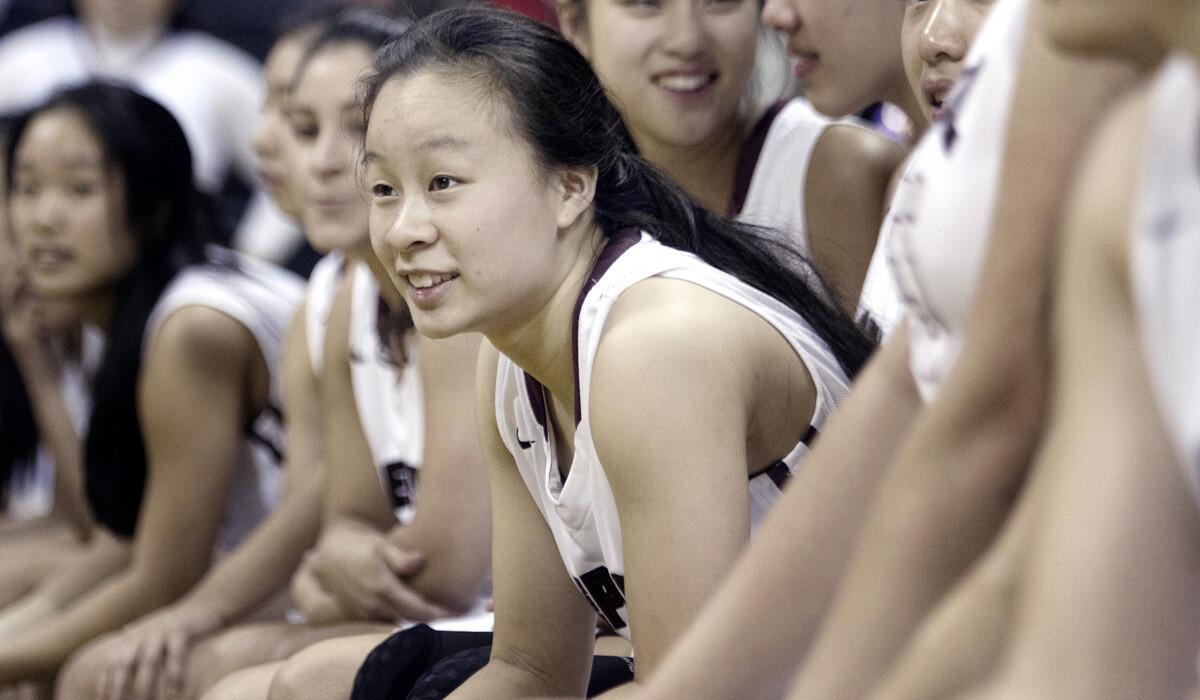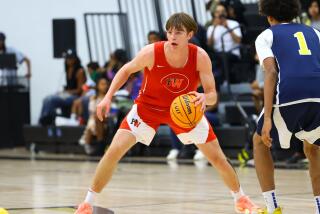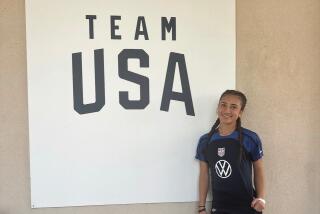Japanese American basketball leagues help girls progress at prep level

Mark Keppel High Schoolâs Lauren Saiki sits with her teammates after winning a game against Redondo Union at Cal State Long Beach on March 21. Mark Keppel won against Redondo Union 48-44 and their first CIF title ever. Saiki will be playing for Division 1 West Virginia University.
Standing just 5 feet 3, Lauren Saiki was sometimes the smallest player on the basketball court. But her signature thread-the-needle passes and heady ball-handling propelled the point guard and her teams from Alhambra Mark Keppel High to four consecutive playoff appearances, capped by last seasonâs run to the Division II state championship game, a first for the school.
Saiki, 18, has earned a basketball scholarship to West Virginia.
For all this, she can credit the fundamentals she learned while playing for more than a decade in a Japanese American basketball league.
âThat helped build my foundation,â Saiki said. â. . . I really fell in love with basketball.â
Also known as Asian leagues or JA leagues, these organizations â which take up many weekend hours for participants â have been the starting point for many successful high school and now even college careers, particularly for young women.
âAsian leagues give you a great foundation,â said Joe Kikuchi, Saikiâs coach at Keppel. âTheyâll go on to play club and high school; they get a head start from everybody else since theyâve been playing since 6 years old.â
Keppel is a consistent contender, even though the average height of its players is usually 5-4 or 5-5. All but one of the girls on Keppelâs team last season played in a Japanese American basketball league. Three of Saikiâs teammates have known her since they were five, growing up on the same team, Tigers Elite.
Rough estimates put the total of youth and adult players in such leagues in California in the several thousands. There are other JA leagues â bowling, baseball, volleyball â but none are as popular as basketball.
Teams come from a variety of organizations â service clubs, Buddhist temples, community centers â and have so many young participants that a few Japanese American churches in L.A. chose to cancel Sunday School.
The Southlandâs Japanese American community is smaller than its Chinese, Vietnamese or Korean counterparts. Though cities such as Gardena and Torrance have more Japanese American residents than most, there is no sprawling hub for Japanese Americans similar to the huge swath of the San Gabriel Valley populated by Chinese Americans, or Westminster and Garden Grove for Vietnamese Americans.
âRight now, it seems like basketball is the only thing that holds the community together, like the third and fourth generations,â said George Imamura, past president of the South Bay F.O.R. Junior Sports Assn., the largest Japanese American basketball organization in Southern California. âThatâs why I think itâs so important that if thatâs all we have right now, to keep it going.â
The legacy of these teams motivates families like the Sugiyamas to make the 30-mile drive from their home in Torrance to Alhambra for basketball. On a Sunday morning earlier this spring, Claire Sugiyama was in the Alhambra High gym bleachers with about a dozen parents and grandparents to watch her daughter Sarah play with the Tigerettes Pulelehua sixth-grade team.
Sarah comes from a long line of Tigers â her grandfather was a founder of the Tigers Youth Club, and her father, who coaches the team, also played basketball with the organization.
âHe just felt she needed to play with Tigers,â Claire Sugiyama said. âShe was born with stripes.â
The Japanese American Optimist Club girlsâ league began about 50 years ago to give children of Japanese American descent the opportunity to play basketball at a time when they were not allowed to play elsewhere, said Leland Lau, league commissioner. When he became commissioner about 20 years ago, there were about 50 girlsâ teams. Today, there are nearly 130.
âItâs a factory of point guards,â he said.
The leaguesâ success in getting girls onto high school teams has even attracted non-Asian players, Lau said. The high intermarriage rate in the Japanese American community is also a factor in the leaguesâ increasing diversity.
Competition can be fierce, said Kiki Yang, 18, a four-year starter at Pasadena Poly High and three-time winner of the Prep Leagueâs most-valuable-player award.
Yang, who will play at Claremont McKenna College next season, learned to play basketball with the Pasadena Bruins when she was in second grade.
âIt gave me more confidence,â she said. âIt exposes you to the sport and allows you to make friends from different schools.â
The strength of these friendships convinced Kylie Fujioka to transfer to Keppel for her senior year. âThere were a lot of closer schools, but the entire varsity team, Iâve known them since elementary school through Asian league,â said Fujioka, who will play for Cal State Monterey Bay in the fall. âEven though I had never played with them before, I had spent my entire life playing against them.â
Kayla Sato, 17, credits the skills she learned on her F.O.R. basketball team with helping her make varsity at West Torrance High.
âThis community is like a family,â said Sato, who will play next year at Westmont College. âThrough one connection, there were so many doors.â
Satoâs West Torrance team won a CIF Southern Section title this year, as did North and South Torrance highs, all of which have rosters filled with JAO players. Early training in the leagues often teaches players to be quick and nimble ball-handlers and accurate outside shooters.
Saikiâs Keppel teammate Kelli Kamida set a Southern Section record last season with 16 three-pointers in a game against Montebello.
Girls who want more competition often will join club teams to improve their skills before high school. Although basketball is a sport that places a premium on height, the lack of it has not been an impediment for Japanese American girls, Lau said.
Many of the JAO leagueâs best-known alumni are shorter point guards such as Jamie Hagiya, a former USC point guard who is 5-3, or Natalie Nakase, who played for UCLA and stands 5-1 3/4. Nakase became the first female head coach in Japanâs top professional menâs basketball league, and now serves as the Clippersâ assistant video coordinator.
Confidence is key, said Monica Hang, an alumna of the leagues who played in college and is now coach of the Los Angeles Valley College womenâs basketball team.
âBeing 5 foot 2 in JAO doesnât mean youâre a guard,â she said. âSometimes you have to play the forward or center position so it makes you into a complete basketball player. It taught me how to be 5 foot 2 and play as if I was 6 foot 2.â
That confidence will be important for Saiki as she heads to West Virginia.
âIâm nervous because itâs big-time basketball, but Iâm pretty excited because itâs a great experience,â she said. âIâm going to meet a lot of different people and have different experiences than what Iâve had growing up on the West Coast.â
But before she moves 2,500 miles away, sheâll have to graduate and say goodbye to her teammates.
âItâs going to be a bittersweet moment, of course,â Saiki said. âGrowing up with them . . . itâs going to be a lot different. Iâll probably stay in touch with them a lot.â
More to Read
Get our high school sports newsletter
Prep Rally is devoted to the SoCal high school sports experience, bringing you scores, stories and a behind-the-scenes look at what makes prep sports so popular.
You may occasionally receive promotional content from the Los Angeles Times.







